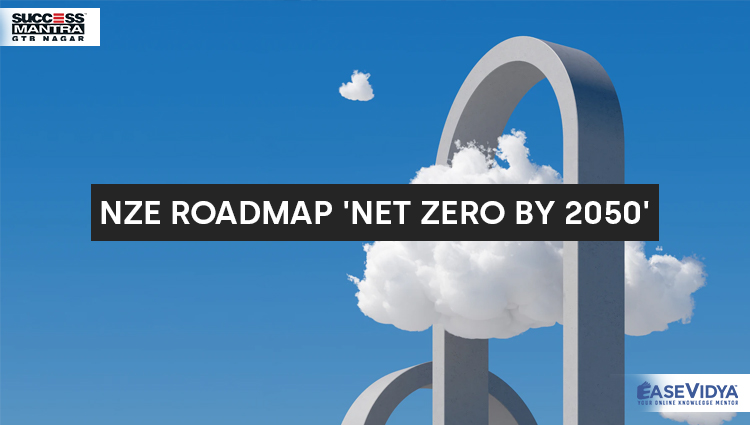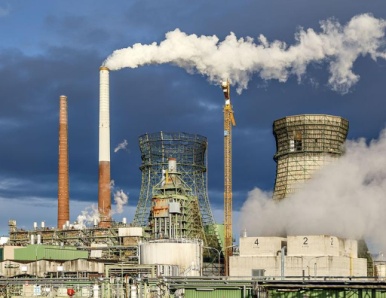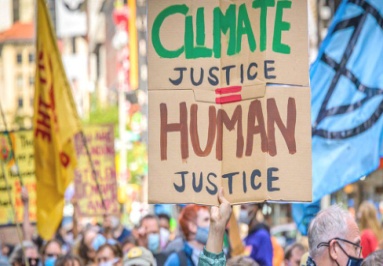
NZE ROADMAP NET ZERO BY 2050
NZE ROADMAP 'NET ZERO BY 2050'

Recently, the International Energy Agency’s (IEA) released its Net Zero Emissions (NZE) Roadmap - named ‘Net Zero by 2050’. It is the World's first comprehensive energy roadmap which comes ahead of the United Nations Conference of the Parties (COP) 26 climate change convention in Glasgow, Scotland in November 2021. ‘Net zero emissions’ refers to achieving an overall balance between greenhouse gas emissions produced and greenhouse gas emissions taken out of the atmosphere.
Need: Climate pledges by governments till date even if fully achieved would fall well short of what is required to bring global energy-related carbon dioxide (CO2) emissions to net zero by 2050 and give the world an even chance of limiting the global temperature rise to 1.5 °C.
AIM OF THE ROADMAP (NZE 2050)

- Examine Impact: To examine the impacts of announced NZE pledges and what they might mean for the energy sector.
- New Energy Pathway: To develop a new energy-sector pathway towards achieving NZE globally by 2050.
- Recommend Governments: To set out key policy recommendations for governments to act upon in the near-term, and a long-term agenda for change to achieve net-zero goals, including with a view to reaching other Sustainable Development Goals.
PRINCIPLES TO BE FOLLOWED
- Technology Neutrality: Technology neutrality, with adoption driven by costs, technological readiness, country and market conditions and trade-offs with wider societal goals. Technology Neutrality is generally described as the freedom of individuals and organizations to choose the most appropriate and suitable technology to their needs and requirements for development, acquisition, use or commercialisation, without dependencies on knowledge involved as information or data.
- Universal Cooperation: Universal international cooperation, in which all countries contribute to net zero, with an eye to a ‘just transition’ and where advanced economies lead.
- Minimizing Volatility: An orderly transition that seeks to minimise stranded assets where possible, while ensuring energy security and minimising volatility in energy markets.
Milestones Set by the Roadmap: More than 400 milestones to guide the global journey to net zero by 2050 which include:
- Fossil Fuels: No investment in new fossil fuel supply projects, and no further final investment decisions for new unabated coal plants.
- Vehicle sale: No sales of new internal combustion engine passenger cars by 2035.
- Electricity Generation: The global electricity sector should reach net-zero emissions by 2040. It calls for annual additions of solar power to reach 630 gigawatts by 2030, and those of wind power to reach 390 gigawatts. Together, this is four times the record level set in 2020.
It suggests the following on global electricity generation towards 2050:
- 714% more renewables.
- 104% more nuclear.
- 93% less coal (and all remaining coal with Carbon Capture and Storage (CCS).
- 85% less natural gas (with 73% of that with CCS).
Significance: It is supposed to provide a pathway to bridge the current gap between rhetoric and reality in reducing GreenHouse Gas (GHG) emissions from the energy and industry sectors.
CRITICISM

Ignorance: IEA did not consider historical emitters, ignoring the principle of ‘climate justice’. Developed countries benefited from the Industrial Revolution at the cost of emitting GHGs, leading to climate change. Hence, they have the economies to decarbonise, allowing space for poor and developing countries to get financing and innovation organised to switch to cleaner energy options.
Regulations Needed: There is potentially an over-reliance on behavioral change to consume less energy. Regulations will be essential to positively motivate constructive social change in economies.
INTERNATIONAL ENERGY AGENCY (IEA)
IEA is an autonomous Intergovernmental Organisation established in 1974 in Paris, France. IEA mainly focuses on its energy policies which include economic development, energy security and environmental protection. These policies are also known as the 3 E’s of IEA. India became an Associate member of IEA in March 2017 but it was in engagement with IEA long before its association with the organization. Recently, India has inked a Strategic Partnership Agreement with the IEA to strengthen cooperation in global energy security, stability and sustainability. The World Energy Outlook Report is released by the IEA annually. Recently, it has released the India Energy Outlook 2021 Report. IEA Clean Coal Centre is dedicated to providing independent information and analysis on how coal can become a cleaner source of energy, compatible with the UN Sustainable Development Goals. The world is facing a formidable task of transforming the energy sector within 30 years in a cost-effective manner, even as the world economy more than doubles in size and the global population increases by 2 billion people. The need for the world to reach NZE by 2050 lies in the major interim steps that need to be taken through 2030 — to engineer cheap and green energy from hydrogen and renewable energy while making them accessible to all.
TEST YOURSELF
Q.1 Which of the following institutes have released a report titled “India: Transforming to a Net-Zero Emissions Energy System''?
- The Energy and Resources Institute (TERI): ANSWER
- National Thermal Power Corporation (NTPC)
- Energy Efficiency Services Limited (EESL)
- None of the above
Q.2 By which of the following years India have targeted to achieve net zero emissions which is an India’s sustainable economic development ambitions?
- 2025
- 2030
- 2045
- 2050: ANSWER
Q.3 Consider the following statements and state which of the following is incorrect in the reference to the above mentioned passage?
- ‘Net zero emissions’ refers to achieving an overall balance between greenhouse gas emissions produced and greenhouse gas emissions taken out of the atmosphere.
- The Paris Climate agreement aims to substantially reduce global greenhouse gas emissions in an effort to limit the global temperature increase in this century to 5 degrees Celsius.
- Only I follows
- Only II follows: ANSWER
- Both I & II are correct
- None is correct
Q.4 The Energy and Resources Institute (TERI) that specializes in the fields of energy, environment and sustainable development is earlier known as ____________?
- Transforming Energy & Resources Institute
- Transforming Energy for Resilient India
- Tata Energy Research Institute: ANSWER
- None of the above
Q.5 Renewable energy often displaces conventional fuel in which of the following areas?
- Space heating
- Transportation
- Electricity generation
- All of the above: ANSWER












0 Comment